NFT
Human Generated: VESA
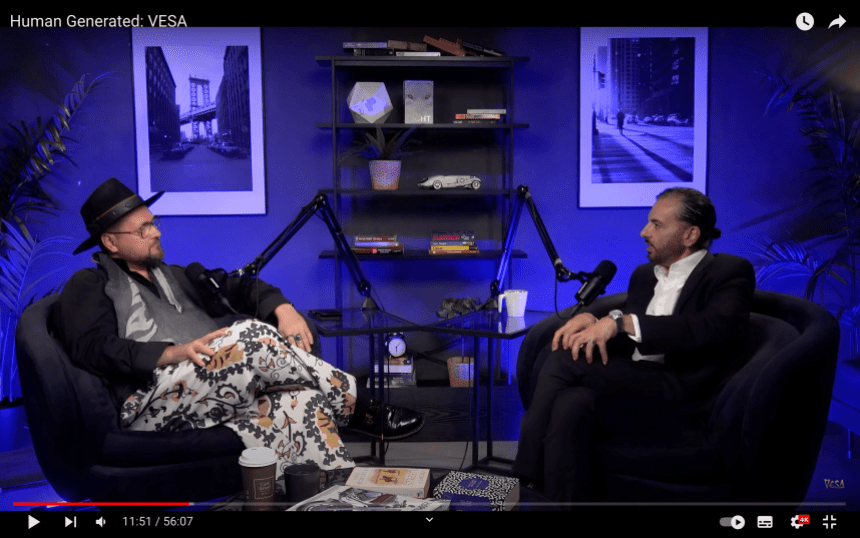
This is Human Generated
This is an interpretation of VESA’s appearance on the Human Generated podcast by Omid Honari. The two met during a day of keynote speeches at the Mohammed Bin Rashid library, where as it turns out, both of their topics touched on not only art and its implications, but also spirituality.
It was no wonder that when VESA and Omid sat down to record this podcast, the deeper topics were soon elaborated on.
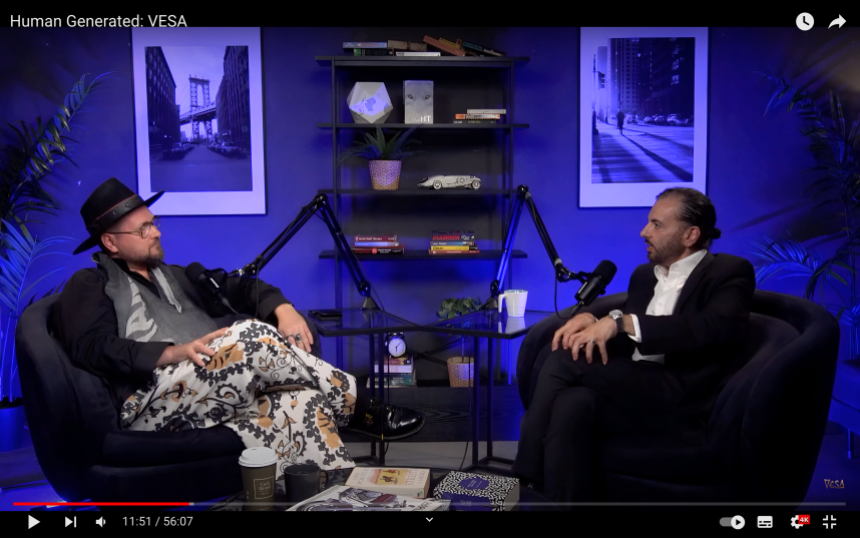 Watch the conversation on Youtube
Watch the conversation on Youtube
Watch it on Spotify
Why read further ( or return)?
Breakdown, links and illustrations:
The conversation took place in late May when Dubai was plunging into the hot temperatures. Vesa told that as a 44-year-old, the elapsing winter was the first where he had enjoyed consistent warm weather, being natively from Finland and having lived in the UK for several years.
‘There’s a lot of cold trauma still to be purged’, he said.
Omid relayed a piece of advice he heard as a boy that coping with cold is much easier than coping with heat, since you always have the option of adding a layer of clothing, but there is only so much you can remove. This advice also speaks to how personal our relationship with the weather and our immediate surroundings is. We rationalize our emotions towards it via stories and these pieces of advice that we tell each other.
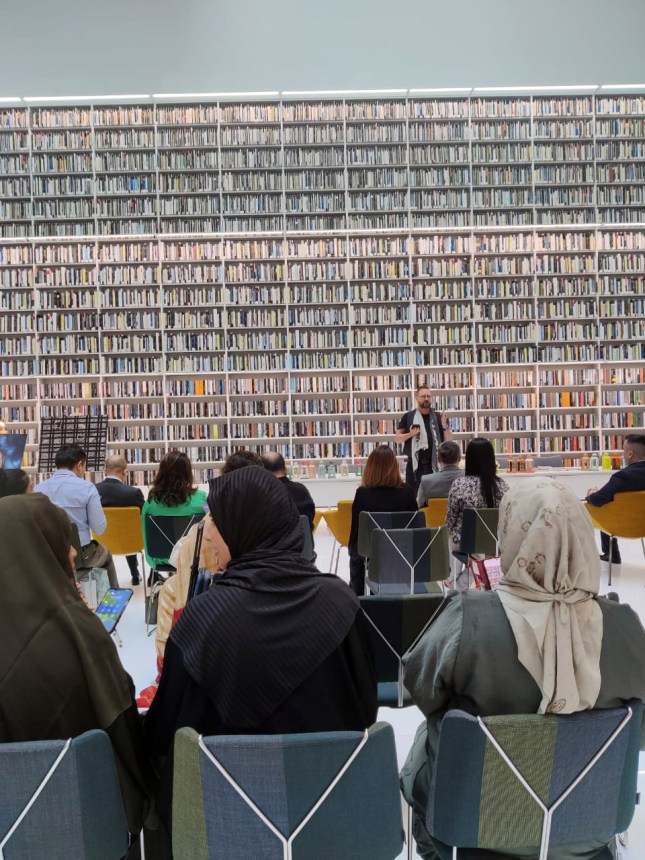 VESA and Omid met at the Mohammed bin Rashid Library in early 2023, where they both were speaking.
VESA and Omid met at the Mohammed bin Rashid Library in early 2023, where they both were speaking.
New Horizons
To delve right into the mouth of the beast, Omid poses an interesting proposition of the constellation of new technologies, NFTs, metaverse and the whole Web3 being at odds with the creative arts as we know it.
‘Most respectfully, I disagree with that, VESA starts.
VESA explains that one of the concepts that governs how he views art, and life itself, is Ken Wilber’s Integral Theory. This theory helps to see yourself, your contribution, philosophies, and beliefs as functional parts of the elaborate whole. This way of approaching art is not taught in colleges and universities, where most art history begins or at least emphasises the post-modern period without studying the roots of why humans began creating art in the first place, namely cave painting and body painting.
With a fractionalized outlook on art, new technologies can feel like a jarring, disjointed note in the melody of human creativity, whereas from the Integral point of view, these are tools that if utilized to their utmost potential, will remove the old gatekeeping systems for more creativity to blossom in society.
‘My LUXOR- inspired art gallery is a great example of this. It uses new technologies, it breaks barriers of entry and in substance, it studies the origins of art, VESA says.
‘It’ll take a little bit of time, and whether the traditional art institutions will adopt this remains to be seen, since their interest is so much in identity politics, but for people, this means total freedom’, he explains.
The Luxor Metaverse temple is live with Superworld
Possibilities or threats
Omid agrees that the limitation of the current arts education seems to be that it is taught from the perspective of the current ideological climate, and it must go along the epoch of our time and what that does is hides the vastness of possibility that is currently available.
Intrigued by VESA’s mention of primordial art, Omid asks next how does an artist with a capital A bridge together the gap of something so corporal, so essential as body paint with something as cerebral and intangible as the digital realm.
‘When I saw my first model with full body paint in my studio, I knew that this was it, it was like a superhero had appeared in front of me’, VESA says.
‘But when it comes to embarking on the digital journey, I had no other choice. My method dictated that my originals were digital ever since 2008, and this was a major issue for the art institutions before the advent of NFTs. They would ask for an oil original that I didn’t have’.
“Escapist” was the first bopypainting and photography based collage work VESA made in 2008.
‘The technology that facilitates Bitcoin is the turning point in digital scarcity and digital ownership, because it facilitates digital assets, like artworks, that are as rare as the physical Mona Lisa’.
Omid then points out that isn’t one of the most valuable digital artworks verified on the blockchain a picture of a monkey, homing in on his original point of new technologies diluting actual artistic endeavour.
‘There’s some genius marketing behind that project, and it gains its value also through being an access pass. What it’s not is art’, VESA explains.
‘How is the casual consumer going to gain an education about the difference between these two categories?’, Omid asks.
VESA explains that this is a deeper issue than what meets the eye, how in the words of the cultural critic Camille Paglia we are on the brink of another cultural Renaissance, should we take the steps to get there, but our institutions are not paving the way for our collective consciousness to get there. He also re-iterates the difference between the collectible digital art and the digitized fine art, where the only common factor is the underlying technology. Having said that, VESA expresses how positive it is that the gatekeeping of the old system is coming down due to technological advancements.
His native country Finland is a great example of this, where a lot of government grants are given only to art that perpetuates a certain narrative. This suffocates actual creativity and resembles more a high-school student, who studies what he knows the teacher cares the most about, not what is relevant.
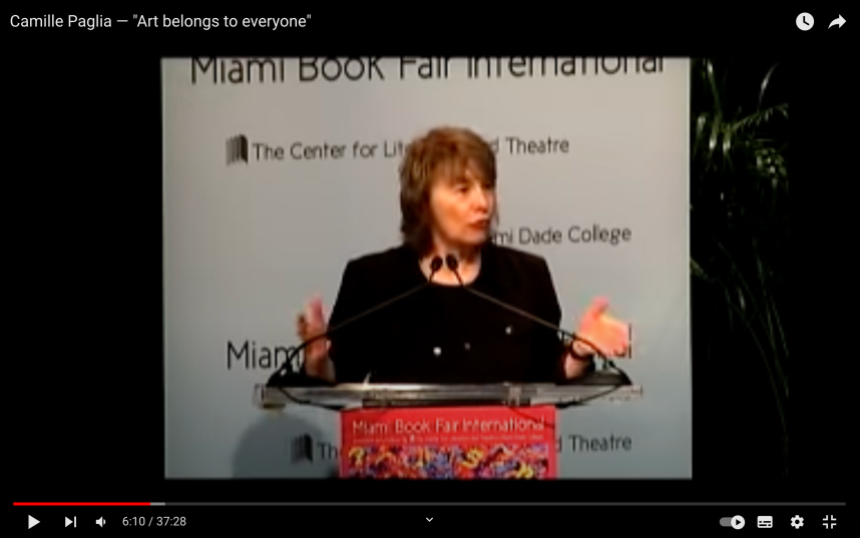 The Camille Paglia lecture “Art belongs to everyone” has been one of the themes that have inspired this direction of thought.
The Camille Paglia lecture “Art belongs to everyone” has been one of the themes that have inspired this direction of thought.
The Origins
As VESA has mentioned Finland, and the general climate of art there, Omid is interested to know how art and VESA came to be.
‘What was the origin story?’, he asks.
‘It’s always been about connection, and the two points in time that come to mind are my connection to music, and especially African drums that lit something up inside me, and my connection to something spiritual that I experienced, when I very nearly drowned as a six-year-old.’, VESA says.
‘At its best, it doesn’t even feel like I am the one who is doing it. And skill comes into play so that it takes a form that others might enjoy as well, but it’s always about that connection that drives everything I do creatively’.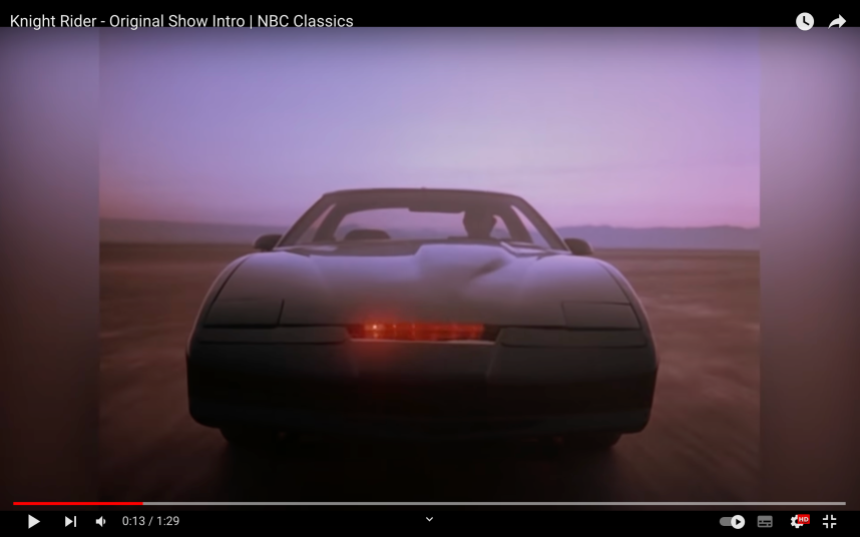
The Knight Rider theme was the first song to get VESA to play to be a rock star as his toy plastic axe as the guitar, sliding on his knees across the room as a 5 year old.
‘So where is the divine for you, then?’ Omid asks.
‘One of the books that talks about this is called Flower of Life, and it explains that this pattern at the very core of everything that comes into being is all coming through the One, but the multitude of expressions that the One takes, is our experience of the world’,
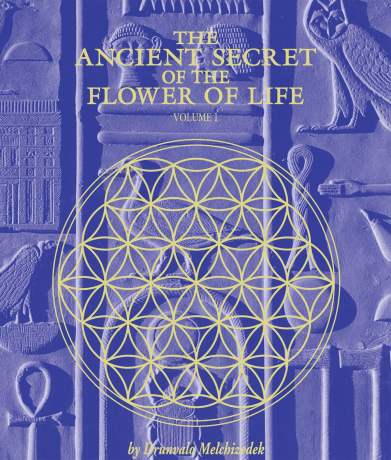
The ancient secret of the flower of life was a significant book to read while travelling shooting a documentary in Egypt and Mexico in 2012.
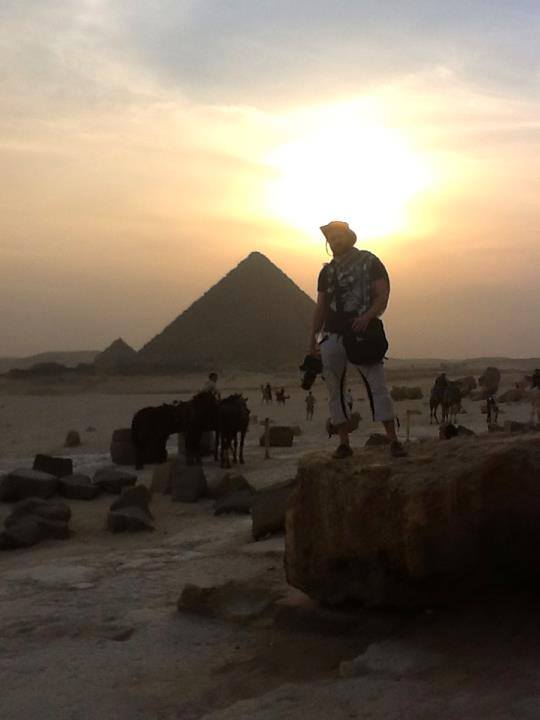
‘In terms of humans, I see the brain much more a receiver than a generator’, VESA says as he hints towards his understanding of the divine.
‘My traumatic experience of nearly drowning was so pivotal to my creative growth because it brought me violently close to that origin point, the point of ultimate connection to God. Maybe I remembered something, maybe I have been here before – it is a possibility’, VESA expands.
Omid illustrates our longing for our origins beautifully through a famous opening to a poem by Rumi, which describes the haunting sound of the reed pipe, longing to return to the whole it was cut from. Perhaps we are like the reed pipe, the divine breath moving through us, but always hankering to get back into unity with our origin.
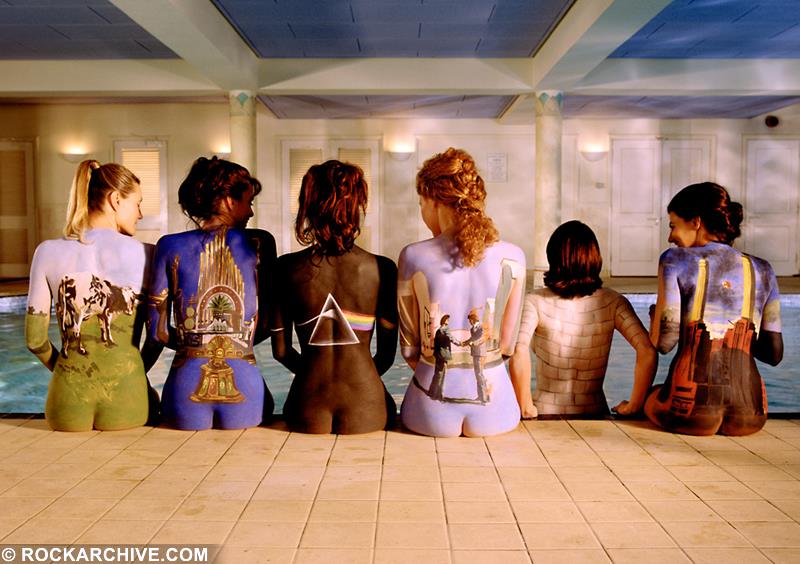
The Pink Floyd “Back catalogue” poster on VESA’s wall as a teenager likely had a significant impact on his life choices later on.
Different bodies
Omid draws a parallel between VESA’s method of bodypainting and seeing inanimate objects as bodies, such as the body of a car that Omid had seen at an event recently. Does VESA see his Art Cars and other painted objects as a continuation of his bodypainting methodology?
‘In some sense, it is still human centric, because these different bodies are still painted for humans to admire’, VESA starts.

The Dr Marwan Tesla covered in art in Dubai also has a digital douible made by Zoan.
‘I also want to be incredibly respectful towards Islam, and not to portray a human as an idol, so I have a lot to study on how to bring to the front my goal of showcasing the divine spark in the human form, how He made us so magnificently’, VESA says.
‘In that spirit of further conversation and discussion, we could go on for so much longer, but I want to invite you to the possibility of having a second episode with you,
‘Inshallah’, VESA says.
Watch the conversation on Youtube
Watch it on Spotify
______
Until next time,
VESA & Lotta
Crypto & NFT Artist
All links to physical, NFTs, and more below
http://linktr.ee/ArtByVesa
NFT
Pudgy Penguins Linked Abstract Chain Goes Live On Mainnet

In an astounding development, Abstract Chain, an Ethereum Layer-2 network launched by Pudgy Penguins’ parent company, Igloo Inc., has gone live on the mainnet. Reportedly, the Ethereum-based Layer 2 blockchain is designed to empower crypto communities and facilitate user-centric Web3 applications.
Despite Abstract Chain’s mainnet launch, Pudgy Penguins’ PENGU token has seen a massive decline. While the token’s descent aligns with the broader market trend, the community remains anxious about its further movements.
Igloo’s Abstract Chain Sees Mainnet Launch
Abstract Chain is now live on the mainnet, opening it up to the public for usage. According to a press release, Abstract Chain is now available for consumers, with the mission of driving mass crypto adoption. Developed by Igloo Inc., the parent company of the popular NFT collection, Pudgy Penguins, Abstract Chain focuses on providing a user-friendly experience.
On January 26, Pudgy Penguins CEO Luca Netz shared an X post announcing Abstract Chain’s mainnet launch. Netz proclaimed that the launch would take place on January 27, effective today.
MONDAY MAINNET ✳️🐧 https://t.co/Cp5naJdoB4
— Luca Netz 🐧✳️ (@LucaNetz) January 25, 2025
Commenting on the launch of Abstract, Netz stated,
The launch of Abstract is more than just a technical milestone—it’s a shift in how everyday users – and not just crypto natives – experience blockchain. We’ve built Abstract to strip away the complexities of crypto, offering an intuitive and enjoyable experience that empowers users to explore and create effortlessly.
Igloo Introduces the Consumer Blockchain Platform- The Portal
Meanwhile, the Abstract Blockchain unveiled The Portal, which the L2 network describes as the consumer blockchain platform. In a more intriguing description, the blockchain network calls The Portal a “Digital Theme Park of Fun” that revolutionizes the way billions interact with blockchain technology.
The Portal allows users to set up a wallet using just their email address, providing seamless access to a vast ecosystem featuring over 100 community-driven decentralized applications (dApps). The platform aligns with Abstract’s vision of merging the simplicity of Web2 with the transformative potential of Web3.
Abstract Chain’s Zero-Knowledge Rollups
Leveraging ZKsync’s ZK stack, Abstract Chain utilizes zero-knowledge rollups. Reportedly, it provides scalable and cost-effective on-chain solutions with reduced transaction fees.
In response to Abstract’s mainnet launch, ZKsync co-founder Alex Gluchowski cited,
For blockchain to reach the masses, we must abstract away the complexity. Users need to experience better apps, builders need to have more engaged users, and creators need to be rewarded for their efforts – while cutting out unnecessary middlemen. Abstract building for everyone, not just Web3 power-users, is the path to get the next billion onchain.
Pudgy Penguins’ PENGU Token Falls 11%
Echoing the broader market sentiment, Pudgy Penguins’ PENGU token dropped by more than 11% in a day despite Abstract Chain’s mainnet launch. Mainly triggered by China’s DeepSeek AI launch, the crypto market is bleeding today, with Bitcoin slipping below $99k.
As of press time, PENGU is exchanging hands at $0.2282, with a decrease of 4.5% over the last seven days. In a month, the token has seen a massive fall of 37%. However, PENGU’s 24-hour trading volume has seen a hike of 48%, currently at $376 million. PENGU token’s substantial decline follows its last month’s remarkable surge that earned a staggering 14,500x return for an investor. With an initial investment of just $6, the investor made a profit of $87K.
Disclaimer: The presented content may include the personal opinion of the author and is subject to market condition. Do your market research before investing in cryptocurrencies. The author or the publication does not hold any responsibility for your personal financial loss.
NFT
CyberKongz Receives Wells Notice from SEC, Vows to Fight for NFT Clarity

The NFT collection CyberKongz said the Securities and Exchange Commission (SEC) will likely charge it.
In a post on X on Monday, the collection said it received a Wells Notice, a letter from the SEC staff that recommends an enforcement action. It commented that the SEC is trying to pull through its laws before Joe Biden’s administration is over.
CyberKongz: “We Will Not Be Silenced”
In a statement, the NFT collection said it was disappointed with the approach of the SEC and vowed to stand up for and fight for greater clarity in the NFT space.
It also mentioned that the SEC raised concerns about its business with Genesis Kongz in April 2021, describing it as a “contract migration.”
It said:
CyberKongz added it intends to fight for clearer crypto regulation, particularly regarding NFT projects.
Eyeing Trump’s Crypto-Friendly Stance
The NFT collection has been vocal about the current administration, which it claims is anti-crypto in its approach. Just recently, as the US Senate Banking Committee was preparing to vote on SEC Commissioner Caroline Crenshaw’s renomination, lawyer Bill Hughes raised concerns about her stance on cryptocurrency regulation. Hughes argued that her renomination one could see as politically hostile to the crypto industry. This stands in contrast to the increasing support for crypto-friendly policies under the incoming administration.
CyberKongz is optimistic that the new administration will provide a more level playing field with a more just regulatory framework. In the meantime, the team comited to support all NFT projects on every blockchain platform.
In the past year, the SEC has acted against several cases related to NFTs. This includes lawsuits against podcast studio Impact Theory and Stoner Cats 2 LLC over unregistered NFT offerings that raised millions. The commission also doled out a Wells Notice to NFT marketplace OpenSea, signaling potential enforcement action.
It is up to wait and see how this enforcement will unfold in the transition of the commission’s leadership. The current SEC Chairman Gary Gensler announced his departure on January 20, in concert with the inauguration of President-elect Donald Trump. Trump has named former SEC Commissioner Paul Atkins, considered friendlier to the crypto industry, as the head of the SEC.
Disclaimer: The presented content may include the personal opinion of the author and is subject to market condition. Do your market research before investing in cryptocurrencies. The author or the publication does not hold any responsibility for your personal financial loss.
NFT
Unyted + Vesa

Unyted we (meta) stand
Many of the fancy metaverse projects take loooong to build and often require developers and budgets just to stay alive. In fact, one of my favorite ones had the whole company collapse around it in the build phase. I absolutely love what we’ve built with Superworld, for example, and what we’re about to release with Asvoria. Both of these require heavy machinery and rotation to come to life—and to be maintained.
Enter Unyted and my newest spatial Web3 space, which allows me to deliver fluent, up-to-date presentations on what’s happening now while also providing an overview of my entire career. I built it mostly by myself, with some guidance and glitch-fixing help from the team—special thanks to Tijana, Saskia, and Florian. I can update it in minutes to include a new project, presentation, or missing link. It’s freeing and necessary.
Unyted is at the forefront of spatial computing, offering innovative solutions that empower users to create, own, and monetize immersive 3D virtual environments. Their platform is designed to facilitate seamless transitions into the metaverse, providing tools for education, collaboration, and personalized digital experiences.
Link to join the metaverse
Link to join the X spaces.
Join us for a session with Ador, Bitcoin LIVE and others tomorrow 20.00 CET
Starting Thursday, we’ll kick things off with a joint presentation with Ador, and from there, we’ll host regular spaces that people can join visually. X is great for connecting with people, but for an artist, a lot is still missing from the full experience. Let’s see if we can bring these two innovations together in a sensible way.
 Watch the Tijana introduction to Unyted as well as my keynote held some time ago regarding web3, metaverse and creativity.
Watch the Tijana introduction to Unyted as well as my keynote held some time ago regarding web3, metaverse and creativity.
Delivering the Metaverse
They’re just starting out, and sure, sure there are a few glitches, but I’ve already given a couple of presentations that feel like a real departure from the world of Zoom. Nothing is ever perfect and getting going and constantly working on it is what keeps the thing alive.
It’s a step closer to delivering something of real value in the metaverse. People showed up to my first keynote in the space done together, they asked questions and then some were left to wonder around the space to explore it on their own. Promises kept. Those matter, after the last run.

I’ve been friends with Florian Krueger since the early blockchain days in London back in 2018, and we’ve collaborated on several projects. He remains one of my favorite people in the crypto space—always looking out for his people and tirelessly fighting for the ethical side of it. I was happy to hear he was starting a new venture and that I could also be a part of.
If you prefer the (virtual) city life?
Key Features of Unyted:
- Modular Environments: Unyted enables users to design and customize digital spaces, such as virtual homes, offices, or campuses, reflecting their unique vision. These environments can be monetized, allowing creators to generate revenue through their virtual properties.
- EdTech Solutions: The platform offers immersive educational experiences with features like AI-driven personalized learning paths, customizable avatars, and virtual classrooms. These tools aim to enhance student engagement and retention, providing scalable and cost-effective solutions for educational institutions.
- Data Protection and Security: Operating under EU regulations and compliant with GDPR, Unyted ensures top-tier data protection. Users maintain complete control over their personal and institutional data, upholding responsible practices in the metaverse.
- Sustainability Commitment: Unyted is dedicated to sustainability, calculating energy consumption and offsetting carbon emissions for each project. Through Unyted.World, users can stake tokens specifically for carbon offsetting, promoting environmental responsibility within the digital landscape.
In many ways what is important about the metaverse is our ability to pre-visualise the world we would like to live in, and then walk toward that direction.
Founded in 2022 by Gaby K. Slezák and Florian Krueger, Unyted envisions a decentralized, independent metaverse where users have equal access to a secure three-dimensional internet. Their mission is to empower individuals to shape their digital futures, fostering a community where creativity and collaboration thrive.
For those seeking to explore the metaverse, Unyted offers consulting services to guide organizations through VR, AR, blockchain, Web3, and Web4 technologies. Their seasoned team provides strategy insights and design expertise to craft unique digital experiences aligned with organizational visions.
Unyted stands as a visionary force in the evolving digital landscape, pioneering innovation while prioritizing user ownership, open collaboration, data protection, and sustainability.
Ador aka BitSavage will join us for the Monday talk in which we also dwell deeper into DAF – the Department of Artistic Freedom
Asvoria coming up soon!

 I’ll soon travel to Bulgaria to film some content in the Asvoria linked Hotel Satoshi Nakamoto, as well as guide the team on advances in our shiny updated metaverse space.
I’ll soon travel to Bulgaria to film some content in the Asvoria linked Hotel Satoshi Nakamoto, as well as guide the team on advances in our shiny updated metaverse space.
The art cars are also gearing up for their auction in Dubai in January, but more on that later.
See you Dec 5th 20.00 CET:
Link to join the metaverse
Link to join the X spaces.
Much to build,
VESA
Crypto Artist, Speaker, Consultant, Writer
All links to physical, NFTs, and more below

-

 Ethereum23 hours ago
Ethereum23 hours agoEthereum Investors Suffer More Losses Than Bitcoin Amid Ongoing Market Turmoil
-

 Ethereum16 hours ago
Ethereum16 hours agoEthereum Fee Plunges To 5-Year Low—Is This A Bottom Signal?
-

 Altcoin23 hours ago
Altcoin23 hours agoTron Founder Justin Sun Reveals Plan To HODL Ethereum Despite Price Drop
-

 Market20 hours ago
Market20 hours agoEthereum Price Fights for Momentum—Traders Watch Key Resistance
-

 Altcoin19 hours ago
Altcoin19 hours agoExpert Predicts Pi Network Price Volatility After Shady Activity On Banxa
-

 Altcoin24 hours ago
Altcoin24 hours agoDogecoin Price Breakout in view as Analyst Predicts $5.6 high
-

 Market18 hours ago
Market18 hours agoIs XRP’s Low Price Part of Ripple’s Long-Term Growth Strategy?
-

 Market22 hours ago
Market22 hours agoSui Meme Coins Surge With Rising DEX Volumes

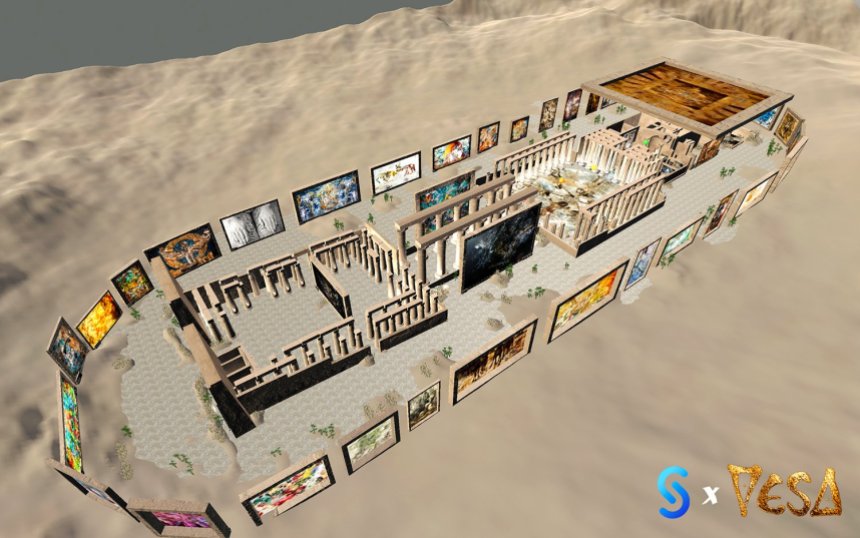
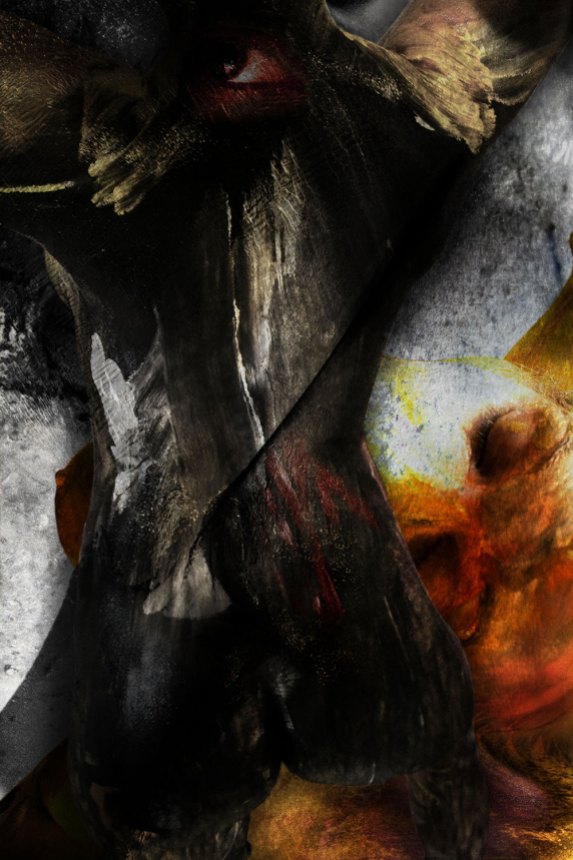



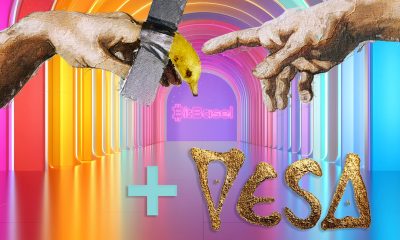




















✓ Share: